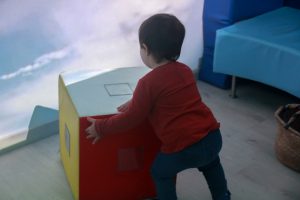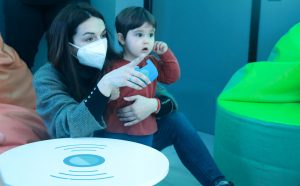Bibiana Escribano
Occupational Therapist. Specialist in pshycomotricity, music therapy and sensory integration.
Read more postsThe childhood stage is key to stimulate the senses, promote the development of the child’s sensory abilities, as well as cognitive development and psychomotor development. Children grow and develop exploring, experimenting, and discovering through their senses.
The ideas that I present to you in this article are applicable in the ‘novelty and exploration’ stage, which includes between 12-18 months in normotypic development. However, these objectives are also applicable and useful for children with early care, early stimulation, or people with disabilities.
In the multi-sensory rooms as well as in the snoezelen rooms we find multiple elements that arouse curiosity and motivate the child to move. These environments are safe and versatile spaces that facilitate exploration and in which activities involving components such as coordination, postural changes, balance, etc. can be proposed to promote psychomotor development. At this stage, we can propose standing activities if we have soft material so that they change their posture, go up, go down or move safely.
We can also play at the scope of objects and their exploration, for example, with very attractive elements under UV light, or with sound objects. It is important to let the child discover their environment, since discovery is a large part of learning.
![]() Therapeutic objective: All this promotes and helps in the development of gait and its evolution.
Therapeutic objective: All this promotes and helps in the development of gait and its evolution.

An environment designed to regulate senses in a controlled way is ideal in the childhood stage since it is in this phase that the child develops the important ability to share attention on an object or event with another person. A multisensory room and also a snoezelen room have motivating stimuli to comment and share, such as: the bubble tube, immersive projections (in the case of SHX environments), optical fibers, or other elements such as soap bubbles, or other sensory material.
![]() Therapeutic objective: Shared care
Therapeutic objective: Shared care

In the case of SHX sensory rooms, they feature a lot of pre-designed and system-embedded content that is projected onto a wall and shows specific early stage audiovisual scenes. These scenes that are shown will help the therapist to work on concepts such as: where are they…? Where were the…? Where do the… go, or where do the… belong?
Thus, we can address certain important concepts to promote in the early or early childhood stage, such as: anticipation, search, categorization, and recognition of elements (where will the fish come out?).
![]() Therapeutic objective: selective attention, categorization, anticipation, …
Therapeutic objective: selective attention, categorization, anticipation, …
In early childhood children have already discovered the procedures and already understand the cause-effect. Multi-sensory classrooms are full of opportunities to activate and reaffirm cause and effect. A switch activates elements such as fiber optics, the bubble tube, or in the case of SHX rooms, it also activates a projection on the wall with sound and vibration, lights, wind, soap bubbles, the vibration of a seat, or even everything. at the same time with the push of a button.
We can, for example, ask the child to play the jungle, after showing him that she does it by pressing a button. Thus the room becomes a jungle, a forest, a beach, or is suddenly under the sea. This helps us to check and reaffirm their interaction with the environment and is a great opportunity for leisure and development.
![]() Therapeutic objective: Interaction with the environment
Therapeutic objective: Interaction with the environment

In addition to working on a specific sense or several at the same time, sensory rooms also promote and greatly facilitate communication and social interaction. Children at this stage smile, wave their hands, pick up objects, point, look, respond with their facial expressions or sounds, etc. Some elements such as lighting effects that match the voice (such as speaking into the microphone and that the room changes color according to the power) help the first phonations, and motivate them to emit their first words.
![]() Therapeutic objective: Social interaction and advance in the communication process.
Therapeutic objective: Social interaction and advance in the communication process.
The multi-sensory rooms allow us to generate many activities with different objectives, stimulate the different sensory systems, and share relaxing and fun moments together. If your users are in this evolutionary stage, do not hesitate to work on these objectives. Observe and listen well to be able to establish the appropriate therapeutic goals and then begin the intervention using the ideas that suit you best. And remember … There is no intervention without an aim!
If you want to learn more about the benefits of Multisensory Environments or see how you could adapt it to your space, therapeutic goals, and users, you can send an email to hello@qinera.com.
Occupational Therapist. Specialist in pshycomotricity, music therapy and sensory integration.
Read more posts